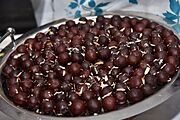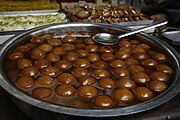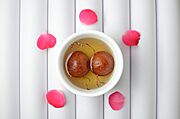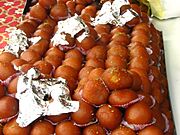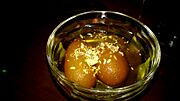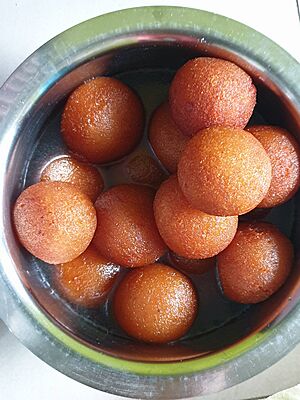Gulab jamun facts for kids

Gulab jamun topped with rose petals
|
|
| Alternative names | Gulab jaman, Lal mohan, Gulab jam, Gulap jam |
|---|---|
| Course | Dessert |
| Region or state | South Asia, Mauritius, Fiji, southern and eastern Africa, the Caribbean, the Malay Peninsula |
| Serving temperature | Hot, cold or at room temperature |
| Main ingredients | Khoa, saffron, maida |
| Variations | Pantua, kalo jam |
Gulab jamun (also spelled gulaab jamun) is a super popular sweet treat. It's a type of dessert that comes from the Indian subcontinent. You'll find it enjoyed in many countries like India, Pakistan, Nepal, and Bangladesh. It's also a favorite in places where many people have South Asian family roots, such as Mauritius, Fiji, and parts of the Caribbean.
This yummy dessert is mostly made from milk solids. Traditionally, a special ingredient called khoya is used. Khoya is milk that has been cooked down until it becomes a soft dough. Today, many recipes use dried or powdered milk instead. Gulab jamun is often decorated with tasty nuts like almonds and cashews to make it even better.
Contents
How Gulab Jamun is Made
Making gulab jamun starts with milk. In places like India, milk is heated slowly until most of the water is gone. What's left are the milk solids, called khoya. This khoya is then mixed with flour (called maida).
Next, small balls are shaped from this dough. These balls are deep-fried in oil or ghee (which is clarified butter). They are fried at a low heat until they are golden brown. After frying, the warm balls are put into a light sugar syrup. This syrup is often flavored with green cardamom, rose water, or saffron. People often enjoy hot gulab jamun with cool vanilla ice cream or kulfi (an Indian ice cream).
The Story Behind Gulab Jamun
The name "Gulab jamun" tells us a bit about its history. The word "gulab" comes from Persian words meaning "flower" (gul) and "water" (āb). This refers to the rose water that gives the syrup its lovely scent. "Jamun" is a Hindi word for a fruit called Syzygium jambolanum, also known as black plum. This fruit is similar in size and shape to the sweet.
Some food experts believe that gulab jamun became popular in India during the Mughal Empire. This was a time when Persian and local Indian cooking styles mixed together. An old Arab dessert called luqmat al-qadi is similar to gulab jamun because it also uses rosewater syrup.
Gulab Jamun for Special Times
Gulab jamun is a very popular sweet for celebrations! People often eat it during festivals, birthdays, and big events like weddings. It's a favorite treat during Muslim celebrations like Eid ul-Fitr and Eid al-Adha. Hindus also enjoy it during festivals such as Diwali and Ganesh Chaturthi. There are many different kinds of gulab jamun to try!
-
Gulab jamun often comes with chashni syrup
-
Served with saffron
-
With vark
Different Kinds of Gulab Jamun
There are many tasty variations of gulab jamun across different regions.
Gulab Jamun in India
Gulab jamun gets its brownish-red color from the sugar in the milk powder. Sometimes, extra sugar is added to the dough before frying. This makes the sweet turn a very dark, almost black color. When it's this dark, it's called kala jamun, which means "black jamun."
Homemade gulab jamun is usually made with khoya, a little bit of flour, baking powder, and ghee. These ingredients are kneaded into a dough, shaped into balls, and then deep-fried. Finally, they are soaked in warm sugar syrup.
In the state of Rajasthan, people make a unique dish called Gulab Jamun ki Sabzi. Instead of soaking the gulab jamun balls in sugar syrup, they are cooked in a savory gravy. This gravy is made with spices, nuts, and tomatoes.
In Madhya Pradesh, a sweet called Mawa Bati is popular. It's like a local version of gulab jamun but is usually bigger. Mawa Bati often has fillings and is not always soaked in sugar syrup.
Gulab Jamun in Bangladesh
In Bangladesh, a sweet called Pantua is very common. It's quite similar to gulab jamun and can be thought of as a Bengali version. There are also two other famous types of jamuns: Golap Jam and Kalo Jam.
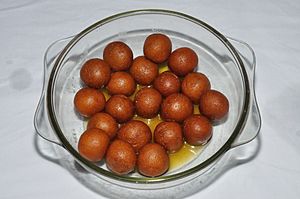
Another sweet called Ledikeni is a type of Pantua. It's said that this sweet was created for Lady Canning, the wife of a Governor-General of India, back in the 1800s.
Gulab Jamun in Nepal
In Nepal, this sweet is known as Lal Mohan. You can find it in almost every sweet shop there. People buy a lot of Lal Mohan during festivals like Tihar and Dashain.
See also
 In Spanish: Gulab yamun para niños
In Spanish: Gulab yamun para niños
- Bamiyeh
- Chak-Chak
- Chè xôi nước
- Doughnut holes
- Leche frita
- List of desserts
- Lokma
- Lyangcha
- Puff-puff
- Rasgulla
- Struffoli
- Tangyuan



